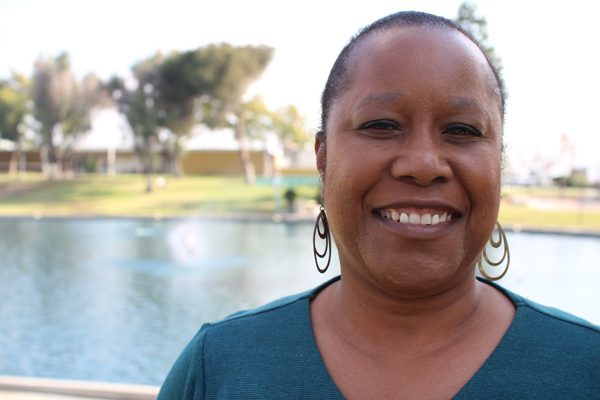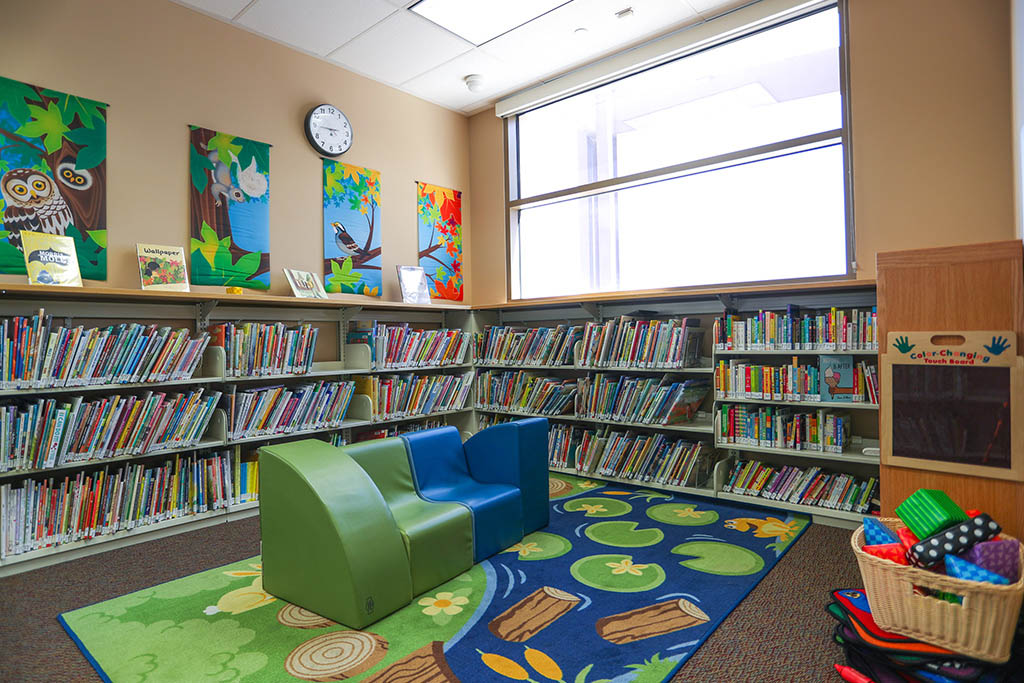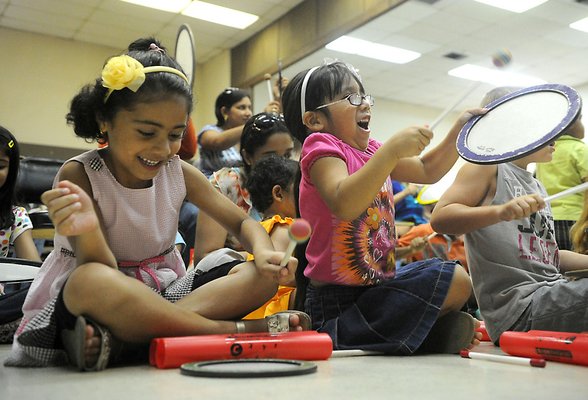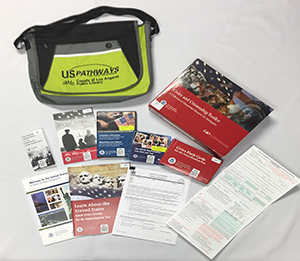The Dress

When I was in the third grade, I was chosen to be the announcer at my school’s spring assembly, which meant I would go on stage and announce each class as they came up to perform. It was an honor for a student to be chosen by their teacher to represent the school in this way, and of course, the announcer was to dress in her best clothing.
I didn’t ask my grandmother, who was raising me, for a new outfit, because I figured we couldn’t afford it, but I told her that the teacher said I needed to look my best. I waited for her to say how she planned to make me look ‘my best,’ instead, the corners of her mouth turned downward, and after a few seconds, she said simply, “Okay.”
Over the next few days, I saw her working at the sewing machine that sat on our dining table. The spool of thread at the top of the machine bobbled rapidly, as her left hand guided a piece of tan material under the machine’s large needle, and her right hand rotated a wheel on the other end. The whirring of the machine’s foot pedal could be heard throughout the house. She was making a dress for me to wear at the assembly, but inwardly, I wanted a new one – not one that was homemade.
My grandmother lived two lives. There was her home life with us, where she cooked dinners of fried potatoes with onions in enormous cast iron skillets and baked biscuits from scratch, on which we’d pile her homemade peach preserves. There was also her work life away from home, where she wore a white uniform and worked in up-to-date kitchens, preparing dinners like roast duck with steamed asparagus.
Some evenings, after working a full day, she would return to her job to serve at dinner parties. She laughed about the time her curiosity about caviar got the best of her. She wanted to taste this delicacy, so when she had a moment alone in the kitchen, she piled a large amount on a cracker and put the whole thing in her mouth. She quickly realized she didn’t like the oily taste at all and turned to the sink and spit it out. “If they knew I had spit that expensive stuff in the sink, I don’t know what they would have done,” she said.
As a “domestic” for two families, my grandmother not only prepared dinners for these families, but she also cleaned their homes, did their laundry and watched their children. At home, she didn’t do much of the housekeeping, nor did she prepare dinners that were anything like those she cooked at work. Being a domestic was the only job my grandmother had while raising my sister, my two brothers and me. My father didn’t always live with us, but he helped out by giving her money toward the rent and taking care of our school needs. The everyday feeding, clothing, and raising, in general, was done by my grandmother. She was the drill sergeant who made sure the girls dusted, washed the dishes and ran the vacuum cleaner, while the boys had trash duty, cut the grass and hedges and shoveled snow from our sidewalks and steps.
During the summers, she would enlist all of us to help with larger projects around the house. She would put on a pair of jeans, which she normally didn’t wear, pull her hair back into a ponytail, and work along side us, as we washed walls or painted rooms. Strands of her thin, silky hair would inevitably break free and become plastered to her perspiring forehead. I guess the fact that we lived with her didn’t allow my grandmother the luxury of smothering us with pampering.
“I’ve worked hard all my life,” she would say, and she didn’t expect any of us to be lazy or unproductive either.
But the laundry was a task that my grandmother did not assign to any of her grandchildren. In our basement was a tall wringer washer that clanked loudly and literally inched itself around the room as it spurted soapy water on the floor. When it finished a load of clothes, my grandmother, who at 5’2” was just a little taller than the washer’s round tub, would crank the handle at the top of the machine and it would slowly squeeze the water from the clothes, piece by piece. She would fill a wicker basket with the wet clothes and hang them on a clothesline in our backyard. Sometimes, she would hang laundry out in the cold Ohio winters, but if the air was too frigid, she hung laundry from clotheslines strung from pipes in our basement.
When she had only a few pieces of clothing to wash, she would place a washboard in a large metal tub and scrub the clothes by hand. Although, she did the family laundry weekly, it was pretty much an all-day job for her on Saturdays. After hours of wringing load after load of clothes, she would recline on the couch in front of the television and talk about how much easier it was to do laundry on her job, because there were modern washers and dryers in those homes. Whenever she needed the convenience of an automatic washer and dryer, such as when it was time to wash our bed quilts or throw rugs and such, we piled loads of our laundry in the back of the car and went to a laundromat – still pretty much an all-day job.
Hard work was something my grandmother had done since she was a little girl. She was one of 21 children born to a father who was a former slave and a mother who was Chickasaw Indian and Black. Her formal education ended in the 4th grade, because she was needed in the fields to help feed their growing family. Her father owned land in Tennessee, where he raised pigs, chickens, and horses, in addition to growing vegetables and fruit trees. So, my grandmother learned at an early age how to plant and harvest crops, as well as how to kill and prepare chickens, rabbits and hogs. Anything that had to be baked – pies, cakes, bread, biscuits – she always made from scratch. She said that by the time she was ten years old, she was as good as her mother in the kitchen. She didn’t, however, teach my sister or me how to cook or bake.
“Don’t mess up my kitchen,” she would say to us, as she shooed us away with a dishtowel.
Even during holiday seasons, when there were big meals to prepare, she assigned us only marginal kitchen duty, such as buttering pans – never actually cooking a dish. She didn’t give us a reason, but I wonder now if she just didn’t want my sister and me to “have to” cook, as she did.
She was only 11 years old when she married. She would say that her parents let her get married because that meant there would be one less mouth to feed. She married a 17-year-old farmer, and went from working in her father’s fields to helping her husband live off the land. After their first son was born, they moved to Cairo, Illinois, because she said, “the South was too segregated” and “there was nothing” in their small town of Selmer, Tennessee. My father, and two more boys were born in Illinois, but they lost one son to whooping cough at the age of two. Their marriage unraveled, and she took the boys and returned to Tennessee in the late 1920s. Her widowed mother had remarried, and my grandmother and her children moved in with her new stepfather and new siblings.
By 1931, she was living in Toledo, Ohio in what she called a “common-law marriage.” She and Thomas had met in Tennessee and relocated to Toledo, where he had family. He was long gone before I was born in the 1950s, but my grandmother always referred to him as a good man, who was good to her children. This was a difficult period for our country, and even in an industrial city like Toledo, the Great Depression forced a lot of people out of work.
President Roosevelt had started a New Deal program known as the WPA (Works Progress Administration), and my grandmother was able to get a position as a seamstress. She made clothing that was distributed by the government to needy families. When World War II broke out, they also made clothing for the troops. She didn’t know how to operate a sewing machine prior to working for the WPA, and she had never hand sewn anything fancier than basic pants, shirts and dresses. So, even though she earned less than $500 a year, the WPA was the first place she was given the opportunity to learn a trade.
In the mid-1950s, my parents were divorcing, and my mother would lose her four children. My grandmother became our legal guardian. At almost 50 years of age, she agreed to raise a one-year-old, a four-year-old, a five-year-old and a seven-year-old.
“They were going to send you kids to the Miami Children’s Home if I hadn’t taken you,” she said.
While I have no memories of my mother abusing us, I do remember how my grandmother sacrificed so that my siblings and I had what we needed. Her electric sewing machine sat at the helm of our table ready to mend a ripped pair of pants or hem a skirt. It was a portable, black machine with ‘Singer’ in gold lettering across its sides, and although it sat inside a suitcase-like carrier, it was rarely moved from the dining table.
Except for the new clothes my father purchased at the beginning of every school year, our clothes came from thrift stores or were from the homes where my grandmother worked. For me, this clothing became “third-hand,” because the dresses, blouses and coats were given to my sister first; after she had worn them for a year or two, I would get them. While I didn’t exactly look like a little rag-a-muffin growing up, I didn’t think my clothes were as pretty as those I saw on little girls in the catalogs that lay on our coffee table.
So, when my grandmother called me in to try on the dress she made for my school assembly, I fidgeted as she maneuvered it over my head. Once the dress was on, I stood stiffly, barely looking down at it.
“It’s gonna be alright,” she said. “I have a few more ideas that’ll make it pretty.”
The next day, unlike the hand-me-downs that were loose-fitting and threadbare from wear, the dress fit like it was made just for me. The bodice of the dress fit snugly and the hemline, which stopped a couple of inches above my knees, flowed with pleats that stood out with the help of a tulle underskirt. My grandmother had made a belt of brown velvet that tied in a big bow at the back, and she had sewn two matching velvet ribbons for my hair.
On the day of the assembly, she parted my hair down the middle into two ponytails and tied them with the ribbons, then finished off my outfit with anklet socks and my patent-leather Easter shoes. As I twirled in front of the mirror, I saw a little girl dressed just as pretty as anyone posing in the Sears catalog. My grandmother leaned back in her chair and smiled.
That day, as I ascended the steps to the stage, I overheard the principal say to a teacher near her, “Isn’t she pretty?” I stood with pride at the microphone, staring out at the audience of students and teachers.
My grandmother, though, didn’t attend the assembly. She had to work.

January 16, 2016










